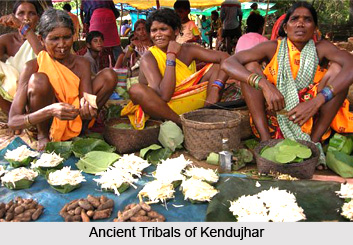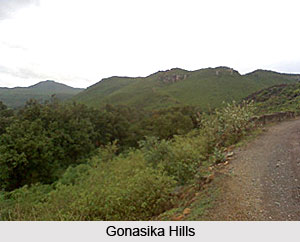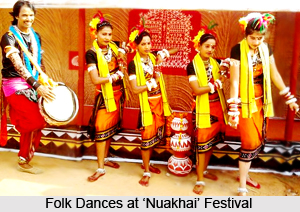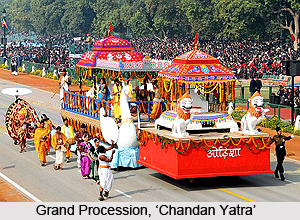Introduction
 Kendujhar District or Keonjhar District is one of the administrative districts of Orissa and has its headquarters located at Kendujhar town. Keonjhar District has the distinction of containing one of the oldest rocks of the world, around 38,000 million years old covering an area of 100 sq kms at Asanpat. It has also the oldest stone inscription of Orissa paleontologically belonging to the Gupta period. In Sitabinj, one finds the fresco paintings in the cave shelter of Ravana Chhaya dating back to 5th Century A.D. Kendujhar District is a land locked district with an area of 8240 sq km. As a sequel to the integration of the feudatory states with Orissa on 1st of January, 1948, the erstwhile princely state of Keonjhar emerged as one of its districts with its head-quarters at Keonjhargarh and since then it has been continuing as such.
Kendujhar District or Keonjhar District is one of the administrative districts of Orissa and has its headquarters located at Kendujhar town. Keonjhar District has the distinction of containing one of the oldest rocks of the world, around 38,000 million years old covering an area of 100 sq kms at Asanpat. It has also the oldest stone inscription of Orissa paleontologically belonging to the Gupta period. In Sitabinj, one finds the fresco paintings in the cave shelter of Ravana Chhaya dating back to 5th Century A.D. Kendujhar District is a land locked district with an area of 8240 sq km. As a sequel to the integration of the feudatory states with Orissa on 1st of January, 1948, the erstwhile princely state of Keonjhar emerged as one of its districts with its head-quarters at Keonjhargarh and since then it has been continuing as such.
Location of Kendujhar District
Kendujhar District is situated in the northern part of Orissa. It is lying between 21 degree 1 minute north and 22 degree 10 minutes north latitude and 85 degree 11 minutes east to 86 degree 22 minutes east longitude and it presents a panorama of millennia, both from the geographical and anthropological point of view. Kendujhar District is surrounded by Singhbhum district of Jharkhand in the north, Jajpur District in the south, Dhenkanal District and Sundargarh district in the west and Mayurbhanj District and Bhadrak District in the east. This district is lying at an altitude of 480 metres altitude.
History of Kendujhar District
 History of Kendujhar District is a historical account which states the growth and development of this Indian district since the period when it was a princely state. The entire part of Kendujhar was a princely state prior to its merging with the eastern Indian state of Odisha. However, the earliest historical episodes of Kendujhar District are shrouded in mystery. Initially, this district was referred to as Keonjhar District and it was associated to the ancient Khijinga territory, which possessed its headquarters at Khijinga Kota. During the 12th century A.D., Kendujhar was made into a separate state, which was then administered by Jyoti Bhanja. At that point of time, this district consisted only of the northern portion of the current district, before Jyoti Bhanja was the ruler of this area. The southern half of Kendujhar District was governed by King Govinda Bhanja during the 15th century. Under his regime, Kendujhar was extended to Sukinda from Singhbhum in the north and till the border regions of Angul, Pallahara and Bonai from Mayurbhanj in the east.
History of Kendujhar District is a historical account which states the growth and development of this Indian district since the period when it was a princely state. The entire part of Kendujhar was a princely state prior to its merging with the eastern Indian state of Odisha. However, the earliest historical episodes of Kendujhar District are shrouded in mystery. Initially, this district was referred to as Keonjhar District and it was associated to the ancient Khijinga territory, which possessed its headquarters at Khijinga Kota. During the 12th century A.D., Kendujhar was made into a separate state, which was then administered by Jyoti Bhanja. At that point of time, this district consisted only of the northern portion of the current district, before Jyoti Bhanja was the ruler of this area. The southern half of Kendujhar District was governed by King Govinda Bhanja during the 15th century. Under his regime, Kendujhar was extended to Sukinda from Singhbhum in the north and till the border regions of Angul, Pallahara and Bonai from Mayurbhanj in the east.
Two areas of Jujhpada and Tillo were bought from the Zamindari of Kantajhuri during the reign of Pratap Balabhadra Bhanja, who ruled from 1764 to 1972 A.D. Tillo and Jujhpada were the portions of Kendujhar which had been granted by the East India Company to Raja Janardan Bhanja in the year 1804. Thereafter, this region did not undergo anymore transformations prior to its association with the Province of Odisha. However, just after merging Kendujhar with Odisha, Jujhpada and Tillo were shifted to the districts of Cuttack and Baleshwar respectively. Several villages known as `Ambo group` were added under the jurisdiction of Kendujhar district. The `Bhuyans` and the `Juangs` are the regional tribes dwelling in this region which are existent since historic times and they have asserted that they are amongst the oldest tribes of the world. On 1st January, 1948, all the feudatory states were officially merged with Odisha, Soon after that, Keonhjar`s name was altered to the modern-day name of `Kendujhar`.
Kendujhar has been ruled by rulers of Bhanja Dynasty whose names have been mentioned below.
| Shri Jagannath Bhanja | (1688-1700) |
| Shri Raghunath Bhanja | (1700-1719) |
| Shri Gopinath Bhanja | (1719-1736) |
| Shri Narasingha Narayan Bhanja | (1736-1757) |
| Shri Dhaneshwar Narayan Bhanja | (1757-1758) |
| Shri Jagateshwar Narayan Bhanja | (758-1762) |
| Shri Pratap Balabhadra Bhanja | (1764-1792 / 1762-1797) |
| Shri Janardan Bhanja | (1794-1825 / 1797-1832) |
| Shri Gadadhar Narayan Bhanja Deo | (1825-1861 / 1832-1861) |
| Shri Dhanurjay Narayan Bhanja Deo | (1861-1905) |
| Shri Gopinath Narayan Bhanja Deo | (1905-1926) |
Geography of Kendujhar District
Kendujhar District consists of a compact area and its extreme length from north to south is nearly 145 km. The average breadth from east to west is about 65 km. It is divided into two widely dissimilar tracts the lower Kendujhar and the upper Kendujhar. The former is a region of valleys and low lands, while the latter includes mountainous highlands with a general slope from north to south. The highlands consisting of clusters of rugged crags afford a safe retreat to its inhabitants in troubled times. The mountaintops have extensive tablelands on their summits, fit both for pasture and for tillage. The average elevation in its central part is about 500 metres. At places, isolated hills rise abruptly from the plains. But most of the areas have a general elevation of over 600 metres, which forms the watershed of some rivers. The Baitarani River takes its rise in the hilly north western division. About half of the area of this district spreading about 4043 sq kms is covered by forests of northern tropical moist deciduous type and contains Sal, Asan, Piasal, etc. The river Baitarani comes out of Gonasika Hills and flows to the north touching the border of Singhbhum district of Jharkhand. The soil is mostly red throughout the district and in the south there is a small patch of black cotton soil. The important minerals available in huge quantity in the district are Iron-ore, Manganese and Chromites.
Climate of Kendujhar District
 The climate of the district includes oppressively hot summer with high humidity. Summer generally commences in the month of March. Temperature begins to rise rapidly attaining the maximum in the month of May. During the summer maximum temperature recorded is around 38 degree Celsius. The temperature in the month of December is lowest that is near about 11 degree Celsius. Sometimes it even drops down to 7 degree Celsius. The average annual rainfall is 1534.5 mms.
The climate of the district includes oppressively hot summer with high humidity. Summer generally commences in the month of March. Temperature begins to rise rapidly attaining the maximum in the month of May. During the summer maximum temperature recorded is around 38 degree Celsius. The temperature in the month of December is lowest that is near about 11 degree Celsius. Sometimes it even drops down to 7 degree Celsius. The average annual rainfall is 1534.5 mms.
Demography of Kendujhar District
According to 2001 Census, total population of Kendujhar District is 15,61,990, of which male population is 7,90,036 and female population is 7,71,954. Further, there are 2067 inhabited and uninhabited villages in Keonjhar district. The rural population is 11,70,152 (5,83,129 Males and 5,82,023 females) giving an average of 571 per inhabited villages.
Administration of Kendujhar District
Administration of Kendujhar District includes three sub divisions namely Anandapur, Champua and Kendujhar. There are 10 tehsils in Kendujhar District and 13 development blocks. Further, administrative set up of Kendujhar District includes 50 Revenue Circles and 286 Gram Panchayats.
Economy of Kendujhar District
The district of Keonjhar is highly rich in mineral resources and has vast deposits of Iron, Manganese and Chrome Ores. About 30 percent of its total area is covered with tracts of dense forests. But the district, in spite of its immense mineral and forest wealth, still remaining economically backward. Kendujhar District is one of the premier mineral producing districts in Orissa. The district occupies a prominent place in the mineral map of the country. Iron ore formations occupy most part of the district which can be traced from Bihar border in the north to Jajpur border in the south. Good deposits of Chromite, an important and strategic mineral are found in Boula area near village Nuasahi of Anandapur sub-division. There are also some other mineral deposits in the district such as Quartzite, Bauxite, Gold, and Lime stone. The two important mineral based industries in the district are the `Kalinga Iron Works` Barbil and the `Ferro-Manganese Plant`, Joda.
Art and Culture of Kendujhar District
 Art and culture of Kendujhar District, Odisha is an impressive reflection of its indigenous festivals, folk dances and folk songs, paintings and inscriptions practised here. The `Asanpat` inscription existent in this part of the country dates back to the 5th century AD and belongs to the Gupta Dynasty. Sitabinj, which is located in Kendujhar District, is reputed for its magnificent paintings which have been performed over a gigantic boulder known as the `Ravanchayya`. This beautiful painting depicts a ruler, King Dishabhaja riding an elephant, followed by his female attendant, soldiers and other horse riders carrying banners, shafts and other weapons. Though a major portion of this painting has faded today, the artwork in general is praiseworthy and the skirt of the female attendant resembles Ajanta murals. Regional inhabitants of Kendujhar are fond of dancing and perform dances in `Akharas`.
Art and culture of Kendujhar District, Odisha is an impressive reflection of its indigenous festivals, folk dances and folk songs, paintings and inscriptions practised here. The `Asanpat` inscription existent in this part of the country dates back to the 5th century AD and belongs to the Gupta Dynasty. Sitabinj, which is located in Kendujhar District, is reputed for its magnificent paintings which have been performed over a gigantic boulder known as the `Ravanchayya`. This beautiful painting depicts a ruler, King Dishabhaja riding an elephant, followed by his female attendant, soldiers and other horse riders carrying banners, shafts and other weapons. Though a major portion of this painting has faded today, the artwork in general is praiseworthy and the skirt of the female attendant resembles Ajanta murals. Regional inhabitants of Kendujhar are fond of dancing and perform dances in `Akharas`.
Dancing is an important part of the social culture of this Indian district and the local tribals engage in colourful dances like Ho Dance, Juang Dance, Chhau Dance and Changu Dance.
 A large variety of festivals are celebrated here with pomp. They include `Ratha Yatra`, `Raja Sankranti`, `Nuakhai`, `Siva Ratri` or `Jagar Yatra`, `Baruni Yatra`, `Chandan Yatra`, `Dola Yatra`, `Rahas Purnima`, `Sarhul`, `Karmapuja`, `Chaitra Parab`, `Bada Osa`, `Uda Parab`, `Sohrai`, `Bodam`, `Ramnavami`, `Dussehra` and others. Odissi dance workshops are often conducted during different times of the year in Kendujhar, in which numerous talented Odissi dancers of Odisha participate.
A large variety of festivals are celebrated here with pomp. They include `Ratha Yatra`, `Raja Sankranti`, `Nuakhai`, `Siva Ratri` or `Jagar Yatra`, `Baruni Yatra`, `Chandan Yatra`, `Dola Yatra`, `Rahas Purnima`, `Sarhul`, `Karmapuja`, `Chaitra Parab`, `Bada Osa`, `Uda Parab`, `Sohrai`, `Bodam`, `Ramnavami`, `Dussehra` and others. Odissi dance workshops are often conducted during different times of the year in Kendujhar, in which numerous talented Odissi dancers of Odisha participate.
At Champua and Anandpur Sub-Division, a Sub-Divisional Youth Festival is organised in association with the District Administration. Two such interesting festivals were observed during 6th December, 2010 at Anandpur and on 7th December, 2010 at Champua. Under the expert supervision and cooperation of Pandit Arup Lal Ghosh, a noted singer from Cuttack, a Hindustani Vocal Workshop was organized for 5 days by the District Cultural Association from 28th December, 2012 till 1st January, 2011. A Tabla workshop was also arranged by the District Cultural Association of Kendujhar District under the guidance of Pandit Harmohan Khuntia of Cuttack. Several famous personalities belonging to Kendujhar, as well as some well-known local organizations of this district also assist in the organization of this workshop.
The District Administration of Kendujhar District is responsible for arranging the Anandpur Mahotsav, wherein various cultural programmes are performed with great gusto.



















